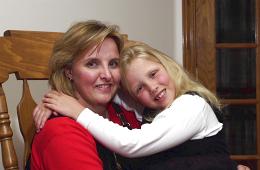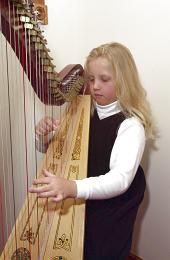![]()
By
Bob Cazier
Deseret News
staff writer
Sunday, April 02, 2000
Valentine's Day has forever changed for Suzanne
McAllister. The gift she received this year eclipsed
candy, flowers or anything else she could have imagined.
In fact, the number 14 on the calendar has great
significance for the Kaysville mother.
 Suzanne McAllister of Kaysville holds daughter Lydia. Ravell Call, Deseret News |
Dec. 14 was one of the worst days of her life. That's
when she discovered Lydia, her 8-year-old daughter, had
type 1 diabetes.
Jan. 14 is another milestone date
— the day Lydia underwent testing in New York City
and was accepted for the first clinical study of a
genetically altered anti-rejection drug to treat people
with diabetes.
And on Feb. 14 she learned Lydia's
blood-sugar levels had returned to normal and that her
diabetes may have been reversed.
The medicine that helped her may
offer new hope for others newly diagnosed with type 1
diabetes. And it's possible that the drug could someday
keep people from ever contracting the disease.
Eventually, the medication might
help people who have had type 1 diabetes for years. Dr.
Kevan Herold, the researcher who conducted the New York
study, plans to test the drug with another procedure in
which insulin-producing cells are transplanted into the
pancreas. The anti-rejection drug might be able to keep
diabetics' bodies from attacking and killing the
transplanted cells.
Neither Lydia nor her mom had any
idea what awaited them when they went Christmas shopping
Dec. 14. Things started out fine. But then Lydia needed
to go to the bathroom. A few minutes later, she needed to
go again.
McAllister, a perinatology nurse at
LDS Hospital who works with high-risk pregnancies,
suspected something was wrong.
"I thought, 'I've got to get
some antibiotics going.' Never did I ever think diabetes.
I drove to the Tanner Clinic (in Kaysville) and I said,
'We need to check this girl.' " Doctors found no
trace of a bacterial infection. But they sent Lydia to
the emergency room at Primary Children's Medical Center
after lab tests showed she had a blood-sugar level of
418. "Normal is 95 to 100," her mother said.
 Lydia McAllister tests her blood sugar levels. Ravell Call, Deseret News |
Doctors at Primary Children's confirmed Lydia had type 1
diabetes, and she was hospitalized three days for insulin
treatment.
Lydia's parents began reading
everything they could find about diabetes. And at 5 a.m.
on Dec. 31, unable to sleep, McAllister opened a copy of
International Countdown, the Juvenile Diabetes Foundation
magazine that had been included in a packet she got at
Primary Children's. There she found a short article about
the clinical study being conducted by Herold, associate
professor of clinical medicine at Columbia University's
Naomi Berrie Diabetes Center. Herold reported he had been
able to reverse type 1 diabetes in animals by treating
them with hOKT3gamma1, the modified anti-rejection drug.
McAllister waited anxiously as the
minutes slowly ticked by, hoping to reach Herold as soon
as he got to his office. But to her dismay, it was a
holiday weekend. All she could do was leave a message on
the doctor's answering machine.
"On Monday, Jan. 3, Dr. Herold
called me at my office," McAllister said. "He
said that Lydia seemed to be a good candidate for the
study and that they had five others in the study so far.
We began talking and made arrangements. On Jan. 13, we
flew to New York."
During the two-week trial at
Columbia Presbyterian Hospital, doses of hOKT3gamma1 were
administered intravenously. Then 12 of Lydia's vital
signs were monitored every half hour for six hours.
Herold first started research with
the drug in the mid-1980s with a colleague at the
University of Chicago. "This new agent is believed
to work by delivering an altered signal to the T cell
receptor and specifically inactivating cells that are
believed to be involved in the development of type 1
diabetes," Herold reported, adding that genetic
alterations made in the anti-rejection drug removed most
of its toxicity.
After six days of treatment, Herold
told the McAllisters that lab tests showed Lydia's
antibodies had been saturated. "That was joyful.
That was really exciting," because it indicated the
damage to Lydia's beta cells had been halted, the mother
said.
Herold cautioned the McAllisters
that recovery, if indeed it came, would be slow.
The medication, however, worked very
quickly for Lydia. During a Salt Lake checkup on Feb. 14,
they found her blood-sugar levels had returned to normal.
 Lydia McAllister practices the harp. A drug may have reversed her diabetes. Ravell Call, Deseret News |
"They did what is called an A1C test. It does an
average of blood sugar that's been going on for three
months," Suzanne McAllister said. "Lydia's A1C
was 5.7. The normal range is 4.7 to 6.4 for
non-diabetics. I went to work that day, and Dr. Herold
called me. And I said, 'We just got her A1C back and we
got a 5.7!' And he said, 'What!' He was just so
thrilled."
"I would say that Lydia's
response has been characteristic of most of the patients
we've seen so far," Herold said of his study.
"They seem to do well. Certainly they tolerate the
drug well."
Still, he's very cautious about
whether hOKT3gamma1 could actually be the means for
curing type 1 diabetes.
"I want to make sure people
don't misunderstand us. We don't know (that the
improvement) is the effect of the drug. This could be the
natural history of the disease, which is to have a
honeymoon soon after the onset of diabetes. . . . We
won't know whether this is a drug effect or just the
natural history and we happened to select people who were
going to go into the honeymoon. We won't know that for
some time yet."
But Herold added, "I'm
certainly starting to get impressed, and I know the
patients have been impressed that things really do seem
to get much better very quickly."
He said other clinical trials of the
drug are needed. And it is possible that one of the
trials might be done in Salt Lake City, Herold said.
In a separate study, Dr. George
Eisenbarth, executive director of the University of
Colorado's Barbara Davis Center for Childhood Diabetes in
Denver, is developing what he believes will lead to a
simple and inexpensive blood test that can detect if a
person is likely to get type 1 diabetes. The test looks
for one of the key antibodies linked to the disorder.
Someday, people found to be at risk for diabetes could be
treated with hOKT3gamma1 as an immunization agent.
Since Feb. 14, Lydia's body has been
producing normal levels of insulin.
But her ordeal isn't over quite yet.
She has her finger pricked three times a day to make sure
her blood sugar stays normal. And Herold has encouraged
the McAllisters to keep giving Lydia low doses of insulin
as a precaution. For the next two years, samples of her
blood will be sent monthly to Herold in New York for
analysis.
Could Lydia's diabetes come back?
"That's something that we don't know for sure,"
Jim McAllister, an air traffic controller, says. But he
and his wife are optimistic. "I think that all of
the bad antibodies were saturated and they're gone,"
Suzanne McAllister said. "Most kids get really
really sick and have more (beta cells) destroyed than
Lydia. I think because we caught it as quick as we did
that we saved a lot of beta cells."
![]()
![]()
![]()
![]()